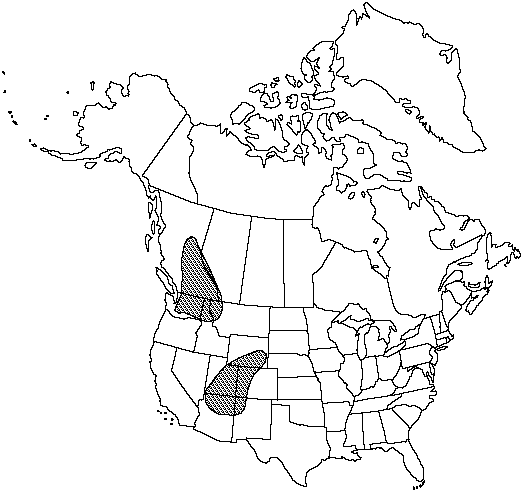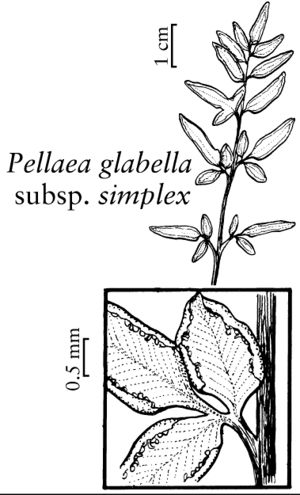Difference between revisions of "Pellaea glabella subsp. simplex"
Taxon 26: 325. 1977.
IllustratedEndemic
Basionym: Pellaea glabella var. simplex Butters Amer. Fern J. 7: 84. 1917
Synonyms: Pellaea atropurpurea var. simplex (Butters) C. V. Morton Pellaea occidentalis subsp. simplex (Butters) Gastony Pellaea suksdorfiana
Treatment appears in FNA Volume 2.
FNA>Volume Importer |
imported>Volume Importer |
||
| (7 intermediate revisions by 2 users not shown) | |||
| Line 7: | Line 7: | ||
|year=1977 | |year=1977 | ||
}} | }} | ||
| − | |basionyms={{Treatment/ID/ | + | |special_status={{Treatment/ID/Special_status |
| + | |code=F | ||
| + | |label=Illustrated | ||
| + | }}{{Treatment/ID/Special_status | ||
| + | |code=E | ||
| + | |label=Endemic | ||
| + | }} | ||
| + | |basionyms={{Treatment/ID/Basionym | ||
|name=Pellaea glabella var. simplex | |name=Pellaea glabella var. simplex | ||
|authority=Butters | |authority=Butters | ||
| + | |rank=variety | ||
| + | |publication_title=Amer. Fern J. | ||
| + | |publication_place=7: 84. 1917 | ||
}} | }} | ||
|synonyms={{Treatment/ID/Synonym | |synonyms={{Treatment/ID/Synonym | ||
|name=Pellaea atropurpurea var. simplex | |name=Pellaea atropurpurea var. simplex | ||
|authority=(Butters) C. V. Morton | |authority=(Butters) C. V. Morton | ||
| − | }}{{Treatment/ID/Synonym | + | |rank=variety |
| + | }} {{Treatment/ID/Synonym | ||
|name=Pellaea occidentalis subsp. simplex | |name=Pellaea occidentalis subsp. simplex | ||
|authority=(Butters) Gastony | |authority=(Butters) Gastony | ||
| − | }}{{Treatment/ID/Synonym | + | |rank=subspecies |
| + | }} {{Treatment/ID/Synonym | ||
|name=Pellaea suksdorfiana | |name=Pellaea suksdorfiana | ||
| − | |authority= | + | |authority= |
| + | |rank=species | ||
}} | }} | ||
|hierarchy=Pteridaceae;Pellaea;Pellaea glabella;Pellaea glabella subsp. simplex | |hierarchy=Pteridaceae;Pellaea;Pellaea glabella;Pellaea glabella subsp. simplex | ||
| Line 28: | Line 41: | ||
}}<!-- | }}<!-- | ||
| − | --><span class="statement" id="st- | + | --><span class="statement" id="st-undefined" data-properties=""><b>Ultimate </b>segments essentially glabrous; sporangia containing 32 spores; spores averaging 60–72 µm diam. n = 2n = 116, apogamous.</span><!-- |
-->{{Treatment/Body | -->{{Treatment/Body | ||
| + | |phenology=Sporulating summer–fall. | ||
|habitat=Calcareous cliffs and ledges, usually on limestone | |habitat=Calcareous cliffs and ledges, usually on limestone | ||
|elevation=900–3000 m | |elevation=900–3000 m | ||
|distribution=Alta.;B.C.;Ariz.;Colo.;Idaho;Mont.;N.Mex.;Utah;Wash.;Wyo. | |distribution=Alta.;B.C.;Ariz.;Colo.;Idaho;Mont.;N.Mex.;Utah;Wash.;Wyo. | ||
| − | |discussion=<p>This western counterpart of Pellaea glabella subsp. glabella is an apogamous tetraploid. A. F. Tryon (1957) and D. B. Lellinger (1985) hypothesized that it might have arisen as a hybrid between the western diploid member of the P. glabella complex (here called subsp. occidentalis) and P. atropurpurea. G. J. Gastony (1988) has shown conclusively, however, that P. glabella subsp. simplex is an autopolyploid derivative of subsp. occidentalis and does not contain genes contributed by P. atropurpurea.</p> | + | |discussion=<p>This western counterpart of <i>Pellaea glabella </i>subsp.<i> glabella</i> is an apogamous tetraploid. A. F. Tryon (1957) and D. B. Lellinger (1985) hypothesized that it might have arisen as a hybrid between the western diploid member of the <i>P. glabella</i> complex (here called <i></i>subsp.<i> occidentalis</i>) and <i>P. atropurpurea</i>. G. J. Gastony (1988) has shown conclusively, however, that <i>P. glabella </i>subsp.<i> simplex</i> is an autopolyploid derivative of <i></i>subsp.<i> occidentalis</i> and does not contain genes contributed by <i>P. atropurpurea</i>.</p> |
|tables= | |tables= | ||
|references= | |references= | ||
| Line 43: | Line 57: | ||
-->{{#Taxon: | -->{{#Taxon: | ||
name=Pellaea glabella subsp. simplex | name=Pellaea glabella subsp. simplex | ||
| − | |||
|authority=(Butters) A. Löve & D. Löve | |authority=(Butters) A. Löve & D. Löve | ||
|rank=subspecies | |rank=subspecies | ||
| Line 50: | Line 63: | ||
|basionyms=Pellaea glabella var. simplex | |basionyms=Pellaea glabella var. simplex | ||
|family=Pteridaceae | |family=Pteridaceae | ||
| + | |phenology=Sporulating summer–fall. | ||
|habitat=Calcareous cliffs and ledges, usually on limestone | |habitat=Calcareous cliffs and ledges, usually on limestone | ||
|elevation=900–3000 m | |elevation=900–3000 m | ||
| Line 56: | Line 70: | ||
|publication title=Taxon | |publication title=Taxon | ||
|publication year=1977 | |publication year=1977 | ||
| − | |special status= | + | |special status=Illustrated;Endemic |
| − | |source xml=https:// | + | |source xml=https://bitbucket.org/aafc-mbb/fna-data-curation/src/2e0870ddd59836b60bcf96646a41e87ea5a5943a/coarse_grained_fna_xml/V2/V2_66.xml |
|genus=Pellaea | |genus=Pellaea | ||
|species=Pellaea glabella | |species=Pellaea glabella | ||
|subspecies=Pellaea glabella subsp. simplex | |subspecies=Pellaea glabella subsp. simplex | ||
| − | |||
| − | |||
| − | |||
| − | |||
}}<!-- | }}<!-- | ||
-->[[Category:Treatment]][[Category:Pellaea glabella]] | -->[[Category:Treatment]][[Category:Pellaea glabella]] | ||
Latest revision as of 21:24, 5 November 2020
Ultimate segments essentially glabrous; sporangia containing 32 spores; spores averaging 60–72 µm diam. n = 2n = 116, apogamous.
Phenology: Sporulating summer–fall.
Habitat: Calcareous cliffs and ledges, usually on limestone
Elevation: 900–3000 m
Distribution

Alta., B.C., Ariz., Colo., Idaho, Mont., N.Mex., Utah, Wash., Wyo.
Discussion
This western counterpart of Pellaea glabella subsp. glabella is an apogamous tetraploid. A. F. Tryon (1957) and D. B. Lellinger (1985) hypothesized that it might have arisen as a hybrid between the western diploid member of the P. glabella complex (here called subsp. occidentalis) and P. atropurpurea. G. J. Gastony (1988) has shown conclusively, however, that P. glabella subsp. simplex is an autopolyploid derivative of subsp. occidentalis and does not contain genes contributed by P. atropurpurea.
Selected References
None.
Lower Taxa
None.
